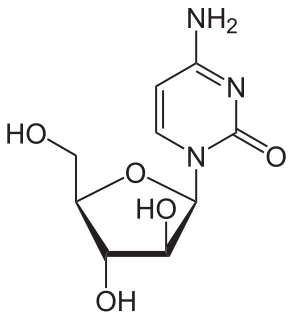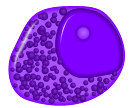
Leukemia, also spelled leukaemia, is a group of blood cancers that usually begin in the bone marrow and result in high numbers of abnormal blood cells. These blood cells are not fully developed and are called blasts or leukemia cells. Symptoms may include bleeding and bruising problems, feeling tired, fever, and an increased risk of infections. These symptoms occur due to a lack of normal blood cells. Diagnosis is typically made by blood tests or bone marrow biopsy.

Cytarabine, also known as cytosine arabinoside (ara-C), is a chemotherapy medication used to treat acute myeloid leukemia (AML), acute lymphocytic leukemia (ALL), chronic myelogenous leukemia (CML), and non-Hodgkin's lymphoma. It is given by injection into a vein, under the skin, or into the cerebrospinal fluid. There is a liposomal formulation for which there is tentative evidence of better outcomes in lymphoma involving the meninges.

Acute promyelocytic leukemia is a subtype of acute myeloid leukemia (AML), a cancer of the white blood cells. In APL, there is an abnormal accumulation of immature granulocytes called promyelocytes. The disease is characterized by a chromosomal translocation involving the retinoic acid receptor alpha gene and is distinguished from other forms of AML by its responsiveness to all-trans retinoic acid therapy. Acute promyelocytic leukemia was first characterized in 1957 by French and Norwegian physicians as a hyperacute fatal illness, with a median survival time of less than a week. Today, prognoses have drastically improved; 10-year survival rates are estimated to be approximately 80-90% according to one study.

Acute erythroid leukemia is a rare form of acute myeloid leukemia where the myeloproliferation is of erythroblastic precursors. It is defined as type "M6" under the FAB classification.

Acute myeloid leukemia (AML) is a cancer of the myeloid line of blood cells, characterized by the rapid growth of abnormal cells that build up in the bone marrow and blood and interfere with normal blood cells. Symptoms may include feeling tired, shortness of breath, easy bruising and bleeding, and increased risk of infection. Occasionally, spread may occur to the brain, skin, or gums. As an acute leukemia, AML progresses rapidly and is typically fatal within weeks or months if left untreated.
Acute monocytic leukemia is a type of acute myeloid leukemia.
Lintuzumab (SGN-33) is a humanized monoclonal antibody used in the treatment of cancer. The drug had been developed by Seattle Genetics as a treatment for acute myeloid leukemia (AML), a condition which results in the deaths of 9,000 people a year in the United States. Lintuzumab targets the CD33 protein, which is expressed in AML and other myeloproliferative diseases, but does not appear in abundance on normal cells.

Acute myeloblastic leukemia with maturation (M2) is a subtype of acute myeloid leukemia (AML).
Lenograstim is a recombinant granulocyte colony-stimulating factor which functions as an immunostimulator. It is developed by Chugai Pharmaceuticals under the brand name Granocyte.

Acute megakaryoblastic leukemia (AMKL) is life-threatening leukemia in which malignant megakaryoblasts proliferate abnormally and injure various tissues. Megakaryoblasts are the most immature precursor cells in a platelet-forming lineage; they mature to promegakaryocytes and, ultimately, megakaryocytes which cells shed membrane-enclosed particles, i.e. platelets, into the circulation. Platelets are critical for the normal clotting of blood. While malignant megakaryoblasts usually are the predominant proliferating and tissue-damaging cells, their similarly malignant descendants, promegakaryocytes and megakaryocytes, are variable contributors to the malignancy.
Acute biphenotypic leukaemia is an uncommon type of leukemia which arises in multipotent progenitor cells which have the ability differentiating into both myeloid and lymphoid lineages. It is a subtype of "leukemia of ambiguous lineage".

Purine analogues are antimetabolites that mimic the structure of metabolic purines.

Childhood leukemia is leukemia that occurs in a child and is a type of childhood cancer. Childhood leukemia is the most common childhood cancer, accounting for 29% of cancers in children aged 0–14 in 2018. There are multiple forms of leukemia that occur in children, the most common being acute lymphoblastic leukemia (ALL) followed by acute myeloid leukemia (AML). Survival rates vary depending on the type of leukemia, but may be as high as 90% in ALL.

Midostaurin is a multi-targeted protein kinase inhibitor that has been investigated for the treatment of acute myeloid leukemia (AML), myelodysplastic syndrome (MDS) and advanced systemic mastocytosis. It is a semi-synthetic derivative of staurosporine, an alkaloid from the bacterium Streptomyces staurosporeus.
R-HDAC, or R-HD-AraC is a chemotherapy regimen that is used, alternating with R-Maxi-CHOP, as part of so-called "Nordic protocol" of treating mantle cell lymphoma. It consists of monoclonal antibody rituximab and high-dose antimetabolite cytarabine.
"7+3" in the context of chemotherapy is an acronym for a chemotherapy regimen that is most often used today as first-line induction therapy in acute myelogenous leukemia, excluding the acute promyelocytic leukemia form, which is better treated with ATRA and/or arsenic trioxide and requires less chemotherapy.
FLAG is an acronym for a chemotherapy regimen used for relapsed and refractory acute myeloid leukemia (AML). The standard FLAG regimen consists of:
- Fludarabine: an antimetabolite that is not active toward AML, but increases formation of an active cytarabine metabolite, ara-CTP, in AML cells;
- High-dose cytarabine : an antimetabolite that has been proven to be the most active toward AML among various cytotoxic drugs in single-drug trials;
- Granulocyte colony-stimulating factor (G-CSF): a glycoprotein that shortens the duration and severity of neutropenia.
ADE is a chemotherapy regimen most often used as an induction or consolidation regimen in acute myelogenous leukemia, especially in poor-risk patients or those refractory to the standard first-line induction with standard "7+3" regimen or who are relapsed after the standard chemotherapy.
DAM in the context of chemotherapy is an acronym that means a chemotherapy regimen most often used as an induction regimen in acute myelogenous leukemia, usually for those who are refractory to the standard "7+3" induction regimen or who has relapsed. But this regimen also can be used as primary, first-line induction therapy.










